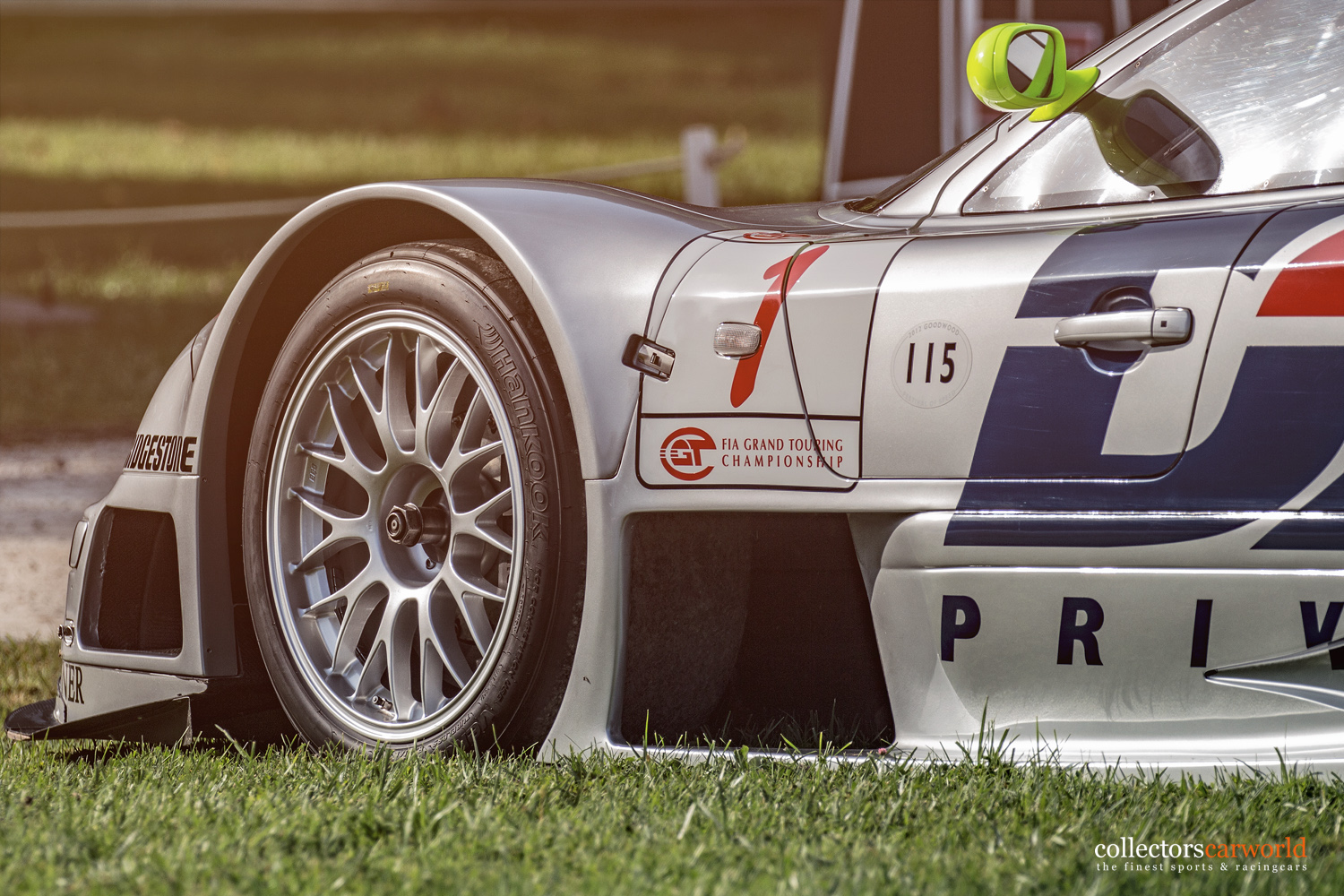At the Chantilly Arts & Elegance Richard Mille 2019. Find out more about our photographer Rainer Selzer.

At the end of the 1996 season the International Touring Car Championship (ITC) imploded, leaving Mercedes-Benz and their competition partner AMG without a platform to showcase their sporting abilities. A new challenge was quickly found in the FIA GT Championship for production based sports cars split over two classes (GT1 and GT2). As an added bonus, cars built to the FIA GT regulations were also eligible to compete in the 24 Hours of Le Mans. Although intended for road car derived Grand Tourers, the regulations simply stated that homologation for GT1 required a minimum of 25 examples to be produced.
In 1996 Porsche were the first to exploit the loophole with their purpose-built 993 GT1 racer, which competed against Ferraris and McLarens that were actually derived from road cars. For incomprehensible reasons, the FIA helped the time-strapped Mercedes-Benz /AMG (as well as several smaller manufacturers) by changing the homologation date from ahead of the first race to the last day of the year. This left the boys from Stuttgart to focus exclusively on their upcoming GT1 racing car.
While the Porsche GT1 car was built around existing 911 (993 and later 996) road-car monocoque, Mercedes-Benz went ahead and started with a clean sheet. A cutting-edge carbon fibre monocoque chassis was drawn up, which was created by Lola Composites in the UK. Suspension was by double wishbones and pull-rod actuated coil-springs over dampers on both ends. Mounted amidships was an AMG modified version of Mercedes’ six-litre V12 engine. Breathing through the mandatory intake-restrictors, it was still good for at least 600 bhp. The quad-cam V12 was mated to a six-speed sequential gearbox.

The rolling chassis was clothed in carbon-fibre body panels that vaguely reminded of the CLK road car the new CLK-GTR racer was supposedly based on. The only bits to find its way from the CLK onto the racing car were the grill and the dashboard. The head and taillights also bore a resemblance with the recently introduced two-door coupe. During the development of the advanced aerodynamics, Mercedes’ engineers actually used a McLaren with new bits grafted on them during testing. From the start of the design work, it took just 128 days to complete the first two cars. This enabled Mercedes to take part in the opening round of the FIA GT Championship, which was held up the road at the Hockenheimring.
The two biggest rivals of the CLK-GTR were Porsche’s revised 996 GT1 and BMW Motorsport’s new long-tail McLaren F1 GTR both of which had been homologated ahead of the season. A revision in restrictor sizes for turbo-charged engines had all but sidelined the Porsches, leaving the CLK-GTRs and F1 GTRs to fight for victory. At the Hockenheimring, the limited development time showed and both CLKs were forced to retire. During the following two rounds, the team was quickly coming to grips with the new car although they could not match the raw speed and ability of JJ Lehto and Steve Soper in the fastest McLaren just yet. After the third race there was a big break in the season to allow the teams to compete in the 24 Hours of Le Mans.
Mercedes-Benz decided to skip the legendary endurance race and instead focus on further developing the CLK-GTR. This immediately yielded results; Bernd Schneider and Klaus Ludwig led a one-two victory for Mercedes at the Nürburgring. The following round, at Spa saw Lehto and Soper shine once more under changeable weather conditions. Schneider hit back by winning the next three rounds, jumping from car to car, when needed, during these races. Subsequent wins at Sebring and Laguna Seca brought Bernd Schneider and AMG Mercedes the driver’s and constructor’s titles. All this with a car that was yet to be homologated.
As was mandated by the FIA, AMG did built a single CLK-GTR road car before the end of the year. Setting it apart from the racing car was an integral rear wing and a seven-litre version of the V12 engine, which was rated at 612 bhp. Mercedes-Benz retained the first road car and it would take another year before the deliveries of the promised production cars would start. The batch of 20 customer cars was eventually built between the winter of 1998 and the summer of 1999. Priced at roughly $1.5 million, the CLK-GTR earned the distinction of being the most expensive road car ever built at the time. In the following years existing cars were modified by AMG/HWA with larger engines and at least five additional cars were built with Roadster bodies.

When AMG Mercedes returned to the FIA GT Championship in 1998 they found only Porsche had come back. Arch-rival BMW had retired their McLaren in favour of a new open-top prototype in a quest for outright glory at Le Mans. Taking a page out of the Mercedes-Benz instruction manual for interpreting the regulations, Porsche had prepared a brand new version of their GT1 car, complete with a carbon-fibre tub. The restrictor imbalance left the Porsches harmless again in the FIA GT; the first two rounds were won by the CLK-GTR. These would be the final outings for the Works cars, although Persson Motorsport continued to run their cars for the remainder of the season.
AMG Mercedes did go to Le Mans this time round and brought a revised version of the CLK ‘inspired’ GT1 racer. Aptly dubbed the CLK-LM, it featured a five-litre V8 engine that was, above all, considerably lighter than the larger V12. Based on the 1989 Le Mans-winning engine, it was also believed to be more reliable than CLK-GTR engine. The V8 was fitted with larger restrictors, so it produced similar horsepower figures as the larger V12. The aero-package was also revised to meet the specific needs of the high-speed track. The nose and roof were both lowered, reducing the drag considerably.
The modifications showed their worth immediately as the two cars entered set the fastest and third times during qualifying. The race quickly turned into a disaster with the engines in both CLK-LMs failing before the four-hour mark. Ironically the race was won by Porsche’s GT1 racer, which could not match the CLK-GTRs in the first two races. After Le Mans, AMG Mercedes returned to the FIA GT Championship with the CLK-LM. The teamed cleaned up the championship, winning all of the eight remaining races. Fittingly Klaus Ludwig won his final race for Mercedes-Benz at Laguna Seca together with Ricardo Zonta. The two relieved Schneider as champion.
For many it came as no surprise that the GT1 cars were banned from the FIA GT Championship for 1999. With all eyes now on Le Mans, Mercedes-Benz commissioned AMG to built an all new racing car to challenge for the outright win. Dubbed the CLR, it proved to be quick but hugely unstable and flipped three times at high speeds. The surviving car was withdrawn from the race and Mercedes-Benz Motorsport chief Norbert Haug vowed never to return to Le Mans. Despite dominating the FIA GT championship for two seasons, the three-year program will forever be remembered by the two disastrous outings at Le Mans.
Find out more on ultimatecarpage.com
Report by Wouter Melissen for ultimatecarpage.com
Photos by rs65photos.com










